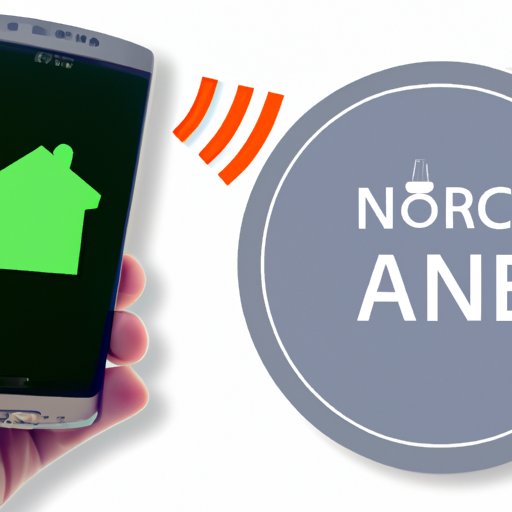I. Introduction
If you’ve recently purchased a new Android phone or tablet, chances are it is equipped with NFC capabilities. NFC stands for Near Field Communication, a technology that allows devices to communicate with each other when they are in close proximity. With NFC, you can quickly share information, make payments, and control devices with just a simple tap.
In this article, we’ll explore the basics of NFC on Android, its impact on our interactions, its uses, security considerations, and what the future may hold for this exciting technology.
II. The Basics of NFC on Android
NFC uses a set of communication protocols that enable wireless data transfer between two devices. When you bring two NFC-enabled devices close to each other, they exchange information automatically.
Android devices have NFC-enabled chips inside them that work in conjunction with an antenna to communicate with other devices. When you place two NFC-enabled devices close together, they establish a wireless connection to share data. This could be a web page, a photo, a document, or any other type of content that can be transferred wirelessly.
Some of the most popular Android devices that support NFC are Samsung Galaxy, Google Pixel, and LG V series phones. However, many other devices also have NFC capabilities. You can check if your device supports NFC by navigating to your device settings and looking for “NFC and Payment.”
III. NFC on Android and its Effects on Interactions
The introduction of NFC on Android has changed the way we interact with our devices and other objects around us. With NFC-enabled smartphones and tablets, we now have the power to communicate with the world around us, in ways that weren’t possible before.
One example of NFC-enabled technology that is changing the way we interact is Google’s Smart Lock. With Smart Lock, you can unlock your Android device, without having to enter a password or PIN, by simply tapping an NFC tag or other NFC-enabled device, such as a smartwatch. This makes it easier and more convenient to access your phone or tablet, while keeping it secure.
IV. 5 Uses of NFC on Android
NFC technology on Android has a wide range of uses and applications. Here are five of the most popular uses of NFC on Android:
A. NFC on Android and Mobile Payments
One of the most common uses for NFC on Android is mobile payments. With NFC-enabled devices, you can simply tap to pay at any retailer that accepts contactless payments. This makes it easier than ever to make purchases both in-store and online quickly and securely. Google Pay, Samsung Pay, and other digital wallet applications all utilize NFC technology to allow quick and simple mobile payments.
B. NFC on Android in Smart Home Control
NFC can also be used to control other smart devices in your home. You can program NFC tags to turn on your lights, adjust your thermostat or turn on your TV with a simple tap. This is where NFC is really shining in home automation – enabling super-easy control of your ambient environment to suit your lifestyle and mood.
C. NFC Digital Business Cards
NFC technology can be used to share digital business cards without the need to carry around paper business cards. You can store all your contact information digitally on an NFC tag, and then share it with others’ NFC-enabled devices with a simple tap. No more searching for a physical business card that can easily be lost or thrown away!
D. Wireless Charging
NFC technology can also be combined with wireless charging technology, allowing for more efficient charging. With NFC-enabled wireless charging, you can simply place your device on a charging pad and tap NFC to start charging.
E. Other Uses
Other uses of NFC on Android include a simple way to set up Wi-Fi connections, pairing devices with Bluetooth, and even playing games that use NFC tags.
V. Security Considerations For Using NFC on Android
As with any technology, there are security risks associated with NFC on Android. For example, hackers could exploit vulnerabilities in NFC to steal personal data or even control your device remotely. It’s important to take steps to keep your NFC-enabled devices secure.
To minimize security risks, it’s important to always use trusted and verified applications when using NFC and to avoid using NFC in public places where it’s difficult to monitor activities. Additionally, use password or biometric options to secure NFC capabilities when they are not needed. Finally, various anti-virus apps are also available that can help protect your data from security threats.
VI. The Future of NFC on Android
The future of NFC on Android looks bright! According to industry experts, new advances in NFC technology will enable even more uses and applications for Android users. One of the most exciting possibilities is the ability to use NFC to store health information and other medical data securely. Additionally, continued research will help improve NFC security, making it even harder for hackers to exploit vulnerabilities. We can expect NFC to continue to evolve and transform our interactions with devices and objects around us for many years to come.
VII. Conclusion
NFC on Android has become an essential technology that is changing the way we interact with the world around us. From mobile payments and smart home controls to digital business cards and wireless charging, NFC has a wide range of uses and applications. With just a simple tap, we can securely exchange information with other NFC-enabled devices around us, easily and conveniently. While there are security considerations to keep in mind, the future of NFC on Android looks bright as technology continues to advance and transform our world.
The possibilities presented by NFC are endless and these are just a few examples of what can be expected in the future. Exciting things are happening and it looks like NFC technology is here to stay.
